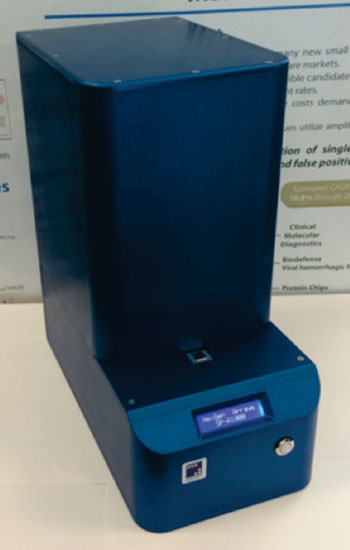Device Developed for Rapid On-Site Pathogen Diagnostics
By Doris Mendieta, Contributing News Editor
Posted on 27 Oct 2014
A novel nanotechnology-based prototype device can detect pathogens such as Ebola and other hemorrhagic fever viruses – quickly and on-site.Posted on 27 Oct 2014
The novel device is being developed by a research team led by Boston University's (Boston, MA, USA) Selim Ünlü, professor of biomedical engineering, and John Connor, professor of medical microbiology. Conventional fluorescent label-based virus detection methods require expensive lab equipment, significant sample preparation, transport and processing times, and extensive user training. A solution in pathogen diagnostics, and thereby also treatment and containment, may come from this device—a rapid, label-free, chip-scale photonic system that can provide affordable, simple, accurate on-site detection, also in resource-limited countries. A potentially game-changing technology, the device identifies individual viruses based on size variations resulting from distinct genome lengths and other factors.

Image: Prototype of the SP-IRIS (single particle - interferometric reflectance imaging sensor), which detects pathogens by shining light from multicolor LED sources on viral nanoparticles trapped onto the sensor surface by a coating of virus-specific antibodies (Photo courtesy of NexGen Arrays).
The first demonstration of the concept, reported in 2010 and developed by a group led by Prof. Ünlü in collaboration with Bennett Goldberg, professor of physics at BU, showed the ability to pinpoint and size single H1N1 virus particles. Now, after 4 years of refining the instrumentation with the collaboration of Prof. Connor's group and researchers at the University of Texas Medical Branch, the team has demonstrated simultaneous detection of multiple viruses in blood serum samples—including viruses genetically modified to mimic the behavior of Ebolavirus and the Marburgvirus.
“Others have developed different label-free systems, but none have been nearly as successful in detecting nanoscale viral particles in complex media,” says Prof. Ünlü, referring to typical (e.g., unprocessed blood) samples that may have a mix of viruses, bacteria, and proteins. He added, “Leveraging expertise in optical biosensors and hemorrhagic fever diseases, our collaborative research effort has produced a highly sensitive device.” Also, the system requires little to no sample preparation time and delivers answers in about 1 hour. “By minimizing sample preparation and handling, our system can reduce potential exposure to health care workers,” said Prof. Connor, “And by looking for multiple viruses at the same time, patients can be diagnosed much more effectively.”
The shoebox-sized, battery-operated prototype – the single particle - interferometric reflectance imaging sensor (SP-IRIS) – detects by shining light from multicolor LED sources on viral nanoparticles trapped onto the sensor surface by a coating of virus-specific antibodies. Interference of light reflected from the surface is modified by the presence of the particles, producing a distinct signal that reveals the size and shape of each particle. The system is capable of high-throughput as the sensor surface is very large and can capture the telltale responses of up to a million nanoparticles.
In collaboration with BD Technologies (Research Triangle Park, NC, USA) and the start-up NexGen Arrays (Boston, MA, USA), the team is now working on making SP-IRIS more robust, field-ready, and fast — ideally delivering answers within 30 minutes—through further technology development and preclinical trials. SP-IRIS devices are now being tested in several labs, including a Biosafety Level-4 (BSL-4) lab at the University of Texas Medical Branch equipped to work with hemorrhagic viruses. Other tests will be conducted at BU’s NEIDL once the facility is BSL-4 approved. Based on the current rate of progress, the instrument could be ready to enter the field in 5 years.
The research, by Daaboul GG et al., appeared in the journal ACS Nano, May, 2014.
Related Links:
Boston University
BU National Emerging Infectious Diseases Laboratories (NEIDL)
NexGen Arrays













